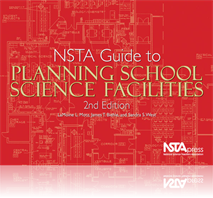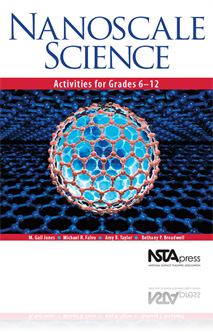All Book Chapters
Book Chapter
A periodic table on the ceiling of a chemistry lab/classroom, footprints and fossils of amphibians and animals in a courtyard sidewalk, a 60-foot slinky suspended from the ceiling, and a tessellation pattern in the floor tile extend science learning ...
Book Chapter
We say it often, and the phrase appears in the National Science Education Standards and many state and local documents as well. “All students should have opportunities in science.” But that vision is harder to achieve in practice. It is especiall...
Book Chapter
Imagine metal eyeglass frames that you can roll in a ball, only to watch it uncoil back to its original shape! How can an inanimate object, such as metal, do such a thing? There is a metal alloy that can do just that and it’s one of the many discov...
Book Chapter
Socks that don’t stink, graffiti-resistant paint, windows and sunscreen that reject UV rays… that’s nanotechnology. Students will learn about some of the latest inventions using nanotechnology by exploring actual products of nanotechnology rese...
Book Chapter
Nanotechnology has opened the door for medical applications that work at the molecular level to diagnose, treat, and prevent disease. This investigation models one approach to treating cancer that uses gold nanoshells to locate and destroy cancer. St...
Book Chapter
Building Small: Nano Inventions
Just as cells were discovered with early light microscopes and Saturn’s rings by the first telescopes, the nanoscale world has emerged due to new tools such as the Atomic Force Microscope (AFM). As a result of being able to build atom by atom a who...
Book Chapter
Too Little Privacy: Ethics of Nanotechnology
Advances in nanotechnology allow us to create unique and tiny labels for manufactured materials, create tiny sensors that can detect the presence of specific molecules, and make machines that are so small they can work invisibly. Through a series of ...
Book Chapter
Just how big is a billion? How tiny is a nanometer? Five hands-on inquiry activities are presented that use measurement and calculations to help students visualize one billion. Students develop mental anchors or references to use when conceptualizing...
Book Chapter
Promise or Peril: Nanotechnology and the Environment
Nanoscience research has made great strides in recent years in areas such as nanomaterials and drug delivery. This success has kindled hope for exciting technological breakthroughs in the near future in areas ranging from new cures for cancer therapi...
Book Chapter
How do you get students to understand a number as small as one-billionth? Through a hands-on dilution activity using food coloring, students will learn about parts per billion. A matching card game helps students further understand one-billionth by g...
Book Chapter
Advances in nanotechnology are due in part to the unique structure and properties of carbon nanotubes and buckyballs. These unusual structures are being studied for their potential use as vehicles for drug delivery, to strengthen materials, and as mi...
Book Chapter
Biological Nanomachines: Viruses
Although nanotechnology is a new and emerging field, nanoscale structures are not new. Small molecules such as water, large molecules such as proteins, and larger, more complex objects such as viruses and nanotubes are naturally occurring and exist a...
Book Chapter
What’s In Your Bag? Investigating the Unknown
In nanoscience, like all scientific endeavors, asking the right questions is a vital part of progress. Our ability to observe how things work at the nanoscale is very limited. We need the use of very advanced microscope technologies as well as other ...
Book Chapter
Nanomagnets: Fun with Ferrofluid
Ferrofluid provides an easy opportunity to introduce students to the fascinating properties of the nanoscale. It is essentially a liquid magnet made of nanosized magnetic particles suspended in water or oil. Not only does it demonstrate the strange a...
Book Chapter
Imagine you could build an object that is a billion times smaller than a meter. What would you build? An entire new field has emerged as a result of a new generation of microscopes that allows scientists to investigate the world at the tiniest of sca...



